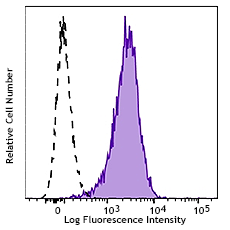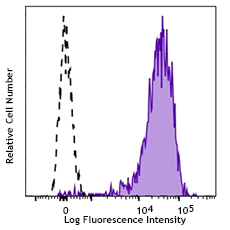- Regulatory Status
- RUO
- Other Names
- IL-6, Angiopoietin-1, Angiopoietin-2, EGF, FGF-basic, CXCL8 (IL-8), PECAM-1, PlGF, VEGF, TNF-α
- Ave. Rating
- Submit a Review
- Product Citations
- publications
Angiogenesis, the development of new blood vessels, is required for many physiological processes including embryogenesis and wound healing. It also plays a key role in solid tumor formation and metastasis, as well as in chronic inflammatory diseases (e.g., inflammatory bowel disease (IBD). The process of angiogenesis is a complex network that involves both pro- and anti-angiogenic factors. The inhibition of vessel formation is an active area of cancer research given the central role angiogenesis plays in tumor growth. An integrated understanding of angiogenic factors is critical for researchers to explore new therapeutic approaches to cancer and other diseases further.
The LEGENDplex™ Human Angiogenesis Panel 1 (10-plex) V02 consists of multiplex assays using fluorescence-encoded beads, and it is suitable for measuring results by common flow cytometers. It allows simultaneous quantification of 10 key targets involved in angiogenesis including IL-6, Angiopoietin-1, Angiopoietin-2, EGF, FGF-basic, CXCL8 (IL-8), PECAM-1 (CD31), PlGF, VEGF, and TNF-α. This assay panel provides higher detection sensitivity and broader dynamic range than traditional ELISA methods. The panel has been validated for use on cell culture supernatant, serum, and plasma samples.
Product DetailsKit Contents
- Kit Contents
-
- Setup Beads: PE Beads
- Setup Beads: Raw Beads
- Human Angiogenesis Panel 1 V02 Premixed Beads
- Human Angiogenesis Panel 1 V02 Detection Antibodies
- Human Angiogenesis Panel 1 V02 Standard, Lyophilized
- LEGENDplex™ SA-PE
- LEGENDplex™ Assay Buffer
- LEGENDplex™ Matrix A2, Lyophilized
- LEGENDplex™ Wash Buffer, 20X
- Plate Sealers
- V-bottom Plate
Product Details
- Verified Reactivity
- Human
- Application
-
Multiplex
Learn more about LEGENDplex™ at biolegend.com/legendplex
Download the LEGENDplex™ software here. - Materials Not Included
-
- Flow Cytometer
- Pipettes and Tips
- Reagent Reservoirs for Multichannel Pipettes
- Polypropylene Microfuge Tubes
- Vortex Mixer
- Sonicator
- Aluminum Foil
- Absorbent Pads or Paper Towels
- Plate Shaker
- Tabletop Centrifuges
- Centrifuge with a swinging bucket adaptor for microtiter plates
- 1.1 mL polypropylene micro FACS tubes, in 96-tube rack
Antigen Details
- Gene ID
- 3569 View all products for this Gene ID 284 View all products for this Gene ID 1950 View all products for this Gene ID 2247 View all products for this Gene ID 3576 View all products for this Gene ID 5175 View all products for this Gene ID 5228 View all products for this Gene ID 7422 View all products for this Gene ID 7124 View all products for this Gene ID 285 View all products for this Gene ID
Related Pages & Pathways
Pages
Related FAQs
- If I don't have a vacuum, how do I remove the liquid from my plate?
-
If you do not have a vacuum, the assay should be run in a V-bottom plate. After centrifugation using a swinging-bucket rotor with a plate adaptor, you can remove the liquid by flicking the plate quickly, dumping the contents into a sink, and patting it dry carefully on a stack of clean paper towels without losing the beads. Alternatively, you can remove the liquid by using a pipette.
- Should I perform the assay with the filter plates or with V-bottom plates?
-
Filter plates or V-bottom plates have been included in some kits for your convenience. A vacuum filtration unit is required to work with the filter plates. However, if you don’t have access to a vacuum manifold or if you prefer, then you can use the V-bottom plates and follow the recommended assay protocols for the type of plates you choose. All plates should be made from low binding polypropylene. Polystyrene ELISA or cell culture plates should not be used.
- After I finish the staining process, how long can I wait before reading my LEGENDplex™ samples?
-
The samples can be kept overnight at 4°C while being protected from exposure to light and be read the next day. There may be a decrease in signal, but overall, the assay results should not be affected. Storing the samples for extended periods of time is not recommended, as it could lead to further reductions in signal.
- What is the shelf life of LEGENDplex™ kits?
-
LEGENDplex™ kits are guaranteed for 6 months from the date of receipt, but may have a shelf life of up to 2 years from the date of manufacture.
- Is special software required for data analysis?
-
Typically flow cytometers generate output files in FCS format (e.g. FCS 2.0, 3.0, or 3.1) and in some cases in list mode file format (LMD). Other software may be available to analyze FCS files. Data generated using LEGENDplex™ kits can be analyzed using the freely available LEGENDplex™ data analysis software. Please check our website for the most updated versions of the software.
 Login / Register
Login / Register 












Follow Us